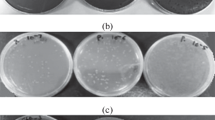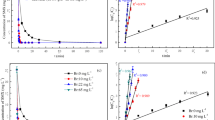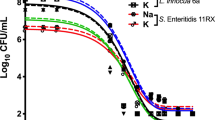Summary
Free residual chlorine and bromine can be generated in water from bromochlorodimethylhydantoin (BCDMH). Efficacy of chlorine from inorganic sources has been studied extensively, but there is much less information on the efficacy of bromine againstL. pneumophila; only a few efficacy studies of organically-derived. halogen appear in the literature and the results from different studies conflict or are difficult to interpret. This paper describes the efficacy of halogen from BCDMH against planktonic, pure cultureL. pneumophila in an industrial cooling water. There was no difference in efficacy between halogen derived from organic or inorganic sources in controlled laboratory experiments. Effective doses in laboratory studies cannot be translated directly to field applications because of significant differences in the microbiology. However, the data suggest that disinfection (>99.9% reduction in viability within 10 min) of planktonic, pure cultureL. pneumophila can be achieved with about 1 ppm free residual halogen (expressed as chlorine) from BCDMH in a typical industrial cooling water.
Similar content being viewed by others
References
Alleman, J.E., J.E. Etzel, E.J. Kirsch, J.C. Conley, and W.F. McCoy. 1987. Chlorine and bromine based disinfection of wastewater effluent. Wate reuse symposium IV of the Am. Water Works Assoc., August 1987.
Baird, I.M., W. Potts, J. Smiley, N. Click, S. Schleich, C. Connole, and K. Davison. 1984. Control of endemic nosocomial Legionellosis by hyperchlorination of potable water, p. 333. In: (Thornsberry, C., A. Balows, J.C. Feeley, and W. Jakubowski, eds.);Legionella: Proceedings of the 2nd Intl. Symp., Am. Soc. Microbiol., Washington, D.C.
Cherry, W.B., B. Pitmanm, P.P. Harris, G.A. Herbert, B.M. Thomason, L. Thacker, and R.E. Weaver. 1978. Detection of Legionnaires' bacterium by direct immunofluorescent staining. J. Clinical Microbiol. 8: 329–338.
Colbourne, J.S., P.J. Dennis, J.V. Lee, and M.R. Bailey. 1987. Legionnaires' disease: reduction in risks associated with foaming in evaporative cooling towers. The Lancet, No. 8534, p. 684.
Conley, J.C. and E.H. Puzig. 1987. Bromine chemistry, an alternative to dechlorination. Condenser Technology Symposium of the Electric Power Research Institute. Paper No. 38.
Conley, J.C., E.H. Puzig, and J.E. Alleman. 1987. Bromine chemistry: an alternative to dechlorination in cooling water and wastewater disinfection. 48th Annual Meeting of the International Water Conference., November 1987, Paper No. IWC-87-42. Pittsburg, PA.
Edelstein, P.H. 1985. Environmental aspects ofLegionella. ASM News. 50(9): 460–467.
England, A.C., D.W. Fraser, G.F. Mallison, D.C. Mackel, P. Skaliy, and G.W. Gorman. 1982. Failure ofLegionella pneumophila sensitivites to predict culture results from disinfectant-treated air-conditioning cooling towers. Appl. Environ. Microbiol. 43: 240–244.
Farkas-Himsley, H. 1966. Disinfection, pp. 554–562, In: (Jolles, Z.E. ed.) Bromine and its compounds, Ernest Benn Ltd., London.
Fellers, B.D., Flock, E.L., and J.C. Conley. 1988. Bromine replaces chlorine in cooling-water treatment. Power. June, 1988, pp. 15–20.
Fliermans, C.B. and R.S. Harvey. 1984. Effectiveness of 1-bromo-3-chloro-5,5-dimethylhydantoin againstLegionella pneumophila in a cooling tower. Appl. Environ. Microbiol. 47: 1307–1310.
Fliermans, C.B., G.E. Bettinger, and A.W. Fynsk. 1982. Treatment of cooling systems containing high levels ofLegionella pneumophila. Water Res. 16: 903–909.
Kozelski, K.J. 1983. Field experience with a simple cooling water biofilm monitoring device. International Water Conference, Paper No. IWC-83-46, Pittsburgh, PA.
Kuchta, J.M., S.J. States, J.E. McGlaughlin, J.H. Overmeyer, R.M. Wadowsky, A.M. McNamara, R.S. Wolford, and R.B. Yee. 1985. Enhanced chlorine resistance of tap water-adaptedLegionella pneumophila as compared with agar medium-passaged strains. Appl. Environ. Microbiol. 50: 21–26.
Kurtz, J.B. and V. Davis, 1988. Efficacy of bromine biocide in cooling-water systems. The Lancet, No. 8580, p. 304.
Massanari, R.M., C. Helms, R. Zeitler, S. Streed, M. Gilchrist, N. Hall, W. Hausler, W. Johnson, L. Wintermeyer, J.S. Muhs, and W.J. Hierholzer. 1984. Continuous hyperchlorination of a potable water system for control of nosocomialLegionella pneumophila infections, pp. 334–336, In: (Thornsberry, C., A. Balows, J.C. Feeley, and W. Jakubowski, eds.),Legionella: Proceedings of the 2nd Intl. Symp., Am. Soc. Microbiol., Washington, DC.
Matson, J.V. and W.G. Characklis. 1982. Biofouling control in recycled cooling water with bromochlorodimethylhydantoin. Paper No. TP-250A, Cooling Tower Institue, Houston, TX.
McCoy, W.F. 1987. Strategies for the treatment of biological fouling, pp. 247–268, In: (Mittleman, M.W. and G.G. Geesey, eds.), Biological fouling of industrial water systems: A problem solving approach, National association of Corrosion Engineers (NACE), Houston, TX.
McCoy, W.F., J.W. Wireman, and E.S. Lashen. 1986. Efficacy of methylchloro/methylisothiazolone biocide againstLegionella pneumophila in cooling tower water. J. Ind. Microbiol. 1: 49–56.
Morton, S., C.L.R. Bartlett, L.F. Bibby, D.N. Hutchinson, J.V. Dyer, and P.J. Dennis. 1986. Outbreak of legionnaires' disease from a cooling water system in a power station. Br. J. Ind. Med. 43: 630–635.
Muraca, P., J.E. Stout, and V.L. Yu. 1987. Comparative assessment of chlorine, heat, ozone, and UV light for killingLegionella pneumophila within a model plumbing system. Appl. Environ. Microbiol. 53: 447–453.
Neblett, T.R. 1976. Use of droplet plating method and cystine-lactose electrolyte-deficient medium in routine quantitative urine culturing procedure. J. Clin. Microbiol. 4: 296–305.
Sergent, R.H. 1986. Enhanced water management using bromine chemistry. Paper No. TP-86-9, Cooling Tower Institute, Houston, TX.
Skaliy, P., T.A. Thompson, G.W. Gorman, G.K. Morris, H.V. McEachern, and D.C. Mackel. 1980. Laboratory studies of disinfectants againstLegionella pneumophila. Appl. Environ. Microbiol. 40: 697–700.
Soracco, R.J., H.K. Gill, C.B. Fliermans, and D.H. Pope. 1983. Susceptibilities of algae andLegionella pneumophila to cooling tower biocides. Appl. Environ. Microbiol. 45: 1254–1260.
Squires, G.E. 1988. Automated feed systems using ORP readings of free halogen. Corrosion '88, National Association of Corrosion Engineers, Paper No. 20.
States, S.J., L.F. Conley, J.M. Kuchta, B.M. Oleck, M.J. Lipovich, R.S. Wolford, R.M. Wadowsky, A.M. McNamara, J.L. Sykora, G. Keleti, and R.B. Yee. 1987. Survival and multiplication ofLegionella pneumophila in municipal drinking water systems. Appl. Environ. Microbiol. 53: 979–986.
Tuovinen, O.H., L. Voss, D.M. Mair, A. Bakaletz, and M.S. Rheins. 1986. Survival ofLegionella pneumophila under different disinfectant and physical conditions. FEMS Microbiol. Lett. 33: 9–13.
Wadowsky, R.M. and R.B. Yee. 1985. Effect of non-Legionellaceae bacteria on the multiplication ofLegionella pneumophila in potable water. Appl., Environ. Microbiol. 49: 1206–1210.
Witherell, L.E., L.A. Orciari, K.C. Spitalny, R.A. Pelletier, K.M. Stone, and R.L. Vogt. 1984. Disinfection ofLegionella pneumophila-contaminated whirlpool spas, pp. 339–340, In: (Thornsberry, C., A. Balows, J.C. Feeley, and W. Jakubowski, eds.),Legionella; Proceedings of the 2nd Intl. Symp., Am. Soc. Microbiol., Washington, DC.
Witherell, L.E., L.A. Orciari, R.W. Duncan, K.M. Stone, and J.M. Lawson. 1984. Disinfection of hospital hot water systems containingLegionella pneumophila, pp. 336–337, In: (Thornsberry, C., A. Balows, J. C. Feeley, and W. Jakubowski, eds.),Legionella: Proceedings of the 2nd Intl. Symp., Am. Soc. Microbiol., Washington, DC.
Author information
Authors and Affiliations
Rights and permissions
About this article
Cite this article
McCoy, W.F., Wireman, J.W. Efficacy of bromochlorodimethylhydantoin againstLegionella pneumophila in industrial cooling water. Journal of Industrial Microbiology 4, 403–408 (1989). https://doi.org/10.1007/BF01569635
Received:
Accepted:
Issue Date:
DOI: https://doi.org/10.1007/BF01569635




